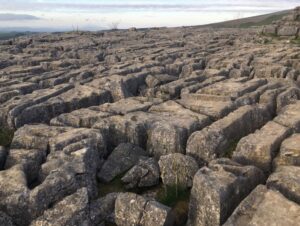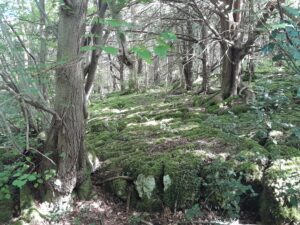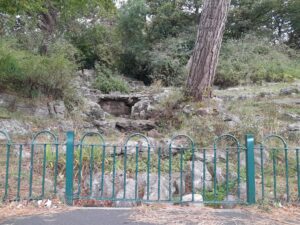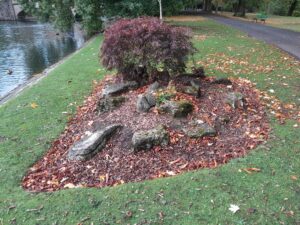Introduction
Bare expanses of limestone dissected into blocks by deep fissures developed on the Mississippian-aged Carboniferous Limestone, referred to as limestone pavements, are iconic landforms in the north of England (Webb 2013), North Wales (Burek & Conway 2000) and in Ireland where the limestone pavements of the Burren in County Clare form part of The Burren and Cliffs of Moher UNESCO Global Geopark. They also occur in parts of northern North America, being particularly well developed in Newfoundland, and in Sweden. More restricted pavement development also occurs in Alpine settings. Limestone pavements are formed through a complex interplay between lithological variation, glacial scour along with subsoil and subaerial weathering and as such are glaciokarstic phenomena (Vincent 2004). As glacial scour no longer occurs at such latitudes (between 50o and 61o N) the pavements are relict features no longer forming today. They are relatively rare, with an estimated total area of 2600 hectares in Great Britain (Webb 2013). Minor areas of limestone pavement occur elsewhere in the British Isles but are of limited extent due to bedrock variation and degree of glacial scour. Approximately one third of the total area of limestone pavement is within the Yorkshire Dales National Park in northern England (Webb 2013) which is the source of many iconic images of bare horizontal surfaces on high ground (Fig. 1). Significant areas of pavement are also developed on the low-lying limestone outcrops around Morecambe Bay in Northwest England but these are often heavily wooded and may be developed on bedding surfaces with a significant dip (Fig. 2).

Figure 1. The iconic pavement at the top of Malham Cove in the Yorkshire Dales National Park. The limestone is heavily polished from the passage of many visitors.

Figure 2. A typical vegetated limestone pavement on dipping strata from the Morecambe Bay region of Northwest England.
The complex surface patterning and small-scale landform development on the pavement surfaces is considered to be mainly a product of post glacial weathering and has a complex descriptive terminology for the runnels, hollows and ridges developed on the block surfaces (Webb 2013). The fissures, where vertical planes of weakness have been opened up as a result of dissolution, are referred to as grykes in Britain and the blocks as clints. The grykes support a diverse flora which include many rare or endangered species of plants and as such are often included in environmental protection programs for their biodiversity (Webb & Glading 1998).
Early Aesthetic Appreciation
These iconic karst landscapes have been valued for their aesthetic qualities since the earliest days of tourism in the Georgian era (1740–1837) when guidebooks extolling the virtues of the area first appeared (e.g. Hutton 1780), and especially so as mass travel became possible after the development of the railways in the 1850s. The Yorkshire Dales area was visited and recorded by many artists including J. M. W. Turner (1775–1851) and the limestone landscape was used as the setting for Charles Kingsley’s ‘Water Babies A fairy tale for a land baby’ an influential children’s book first published in its entirety in 1863.
The social value, and the resulting commercial value, placed on the limestone landscapes resulted in widespread damage to the pavements as a market for ‘water worn’ limestone developed in late Victorian times for use in gardens and as decorative toppings for residential walling. In the 1920s and 1930s, rock gardens became very fashionable, inspired in part by the garden design and plant collecting work of Reginald Farrer (Mitchell 2002), popularized by the publication of ‘My Rock Garden’ (Farrer 1907) and his iconic work ‘The English Rock Garden’ (Farrer 1919). The Farrer family owned and still own today many hectares of limestone pavement as the proprietors of the Ingleborough estate in the Yorkshire Dales National Park.
Town Planning and Pavement Damage
One little discussed aspect of the damage and destruction of limestone pavement has been its incorporation into municipal parks and recreation areas. With the move to city living in the UK, driven by industrialization in the early 19th Century, there was concern amongst the civic leaderships about the need for sanitation and recreation space in the urban sprawl. Cities began developing parks and garden spaces to enable healthy recreation. Many such parks across the north of England incorporated aspects of the relatively nearby limestone landscapes into their design. Lister Park in Bradford opened in 1870 is a good example. Here there is a complete scaled reconstruction, including active waterfalls, of the spectacular geology and scenery of the area around Ingleton in the Yorkshire Dales National Park, including limestone pavements (Murphy 2017). The real Ingleton Waterfalls Trail was developed as a scenic route to attract tourists from the nearby cities of Leeds and Bradford using the industrial rail infrastructure. The Trail opened in 1885 (Bentley 2008) and proved very popular, being visited by 3840 people per day in July 1888, and is still very popular today.
Seaside holiday and bathing resorts also made use of water worn limestone as part of town developments aimed at making them more attractive to tourists. The resort of Southport on the northeast coast of England is one such example. In Hesketh Park, a five-hectare recreation area opened in 1868, an extensive rock garden was commissioned mimicking the original pavement style and appearance, including a dry valley (Fig. 3). Similar though less extensive uses of limestone pavement materials can be found in many municipal parks across the north (e.g., Thompson Park in Burnley, Fig. 4) and the midlands of England (e.g., Perry Hall Park, Birmingham). It is ironic that the need to provide open space recreation for the urban populace contributed to the damage and destruction of the limestone pavements whose aesthetic appeal in the wild in part inspired the urban parks movement.

Figure 3. A landscape reconstructed – representation of limestone pavement and a dry valley in Hesketh Park, Southport.

Figure 4. A smaller scale use of limestone pavement for ornamental purposes in Thompson Park, Burnley.
Twentieth Century Destruction and Conservation
The damage to limestone pavements reached a peak during the 1970s and 1980s when the mechanization of extraction coincided with a boom in interest in gardening. The removal of the top layer of clints leaves a quarried bedding plane surface with remnant grykes filled with rubble. Such an environment is unable to support the biodiversity typical of an undamaged pavement. A review of pavements showed that 40% of the studied pavement area had been destroyed and only 3% of studied sites remained intact (Ward & Evans 1976). Legal protection was provided by a clause in the Wildlife and Countryside Act of Parliament 1981 whereby the provision of limestone pavement orders by the local planning authority made it a criminal offence to damage pavements. This legal statute proved highly effective (Goldie 1993; Webb 1995, 2013) and now all extraction of limestone pavement in England has ceased. Many areas of pavement have been included in the Geological Conservation Review (GCR) which was designed to identify those sites of national and international importance to show all the key elements of the Earth heritage of Great Britain (Waltham et al. 1997). Designation as a GCR site provided an increased level of protection for those areas of limestone pavement within the existing Sites of Special Scientific Interest (SSSI) conservation designation. This is the basic unit for site-based nature conservation legal protection in the United Kingdom.
The Current Situation
Limestone pavement landscapes are still regarded as culturally important. For example, such landscapes featured prominently in the films Robin Hood: Prince of Thieves (1991) and Harry Potter and the Deathly Hallows Part One (2010). The market for waterworn limestone still exists, and packages of recovered stone are widely in garden centers, so there is a risk that illegal quarrying of karst landscapes still occurs. The tightening of legislation in the UK seems to have transferred some illegal quarrying of karst to other areas such as the Republic of Ireland. Irish-sourced waterworn limestone is widely available in the UK, though increased legal protection for Irish pavements came into force as part of the Habitats Directive of the European Union (Murphy and Fernandez 2009). In spite of these limitations, the provision of legal protection to these geologically, biologically and culturally significant landforms in England has proved one of the successes of legal protection of the countryside and hopefully has ensured they will be preserved for generations to come.
